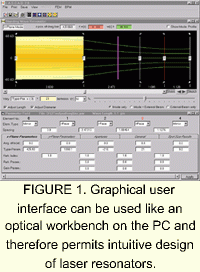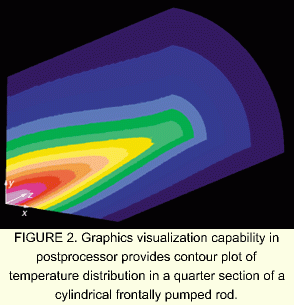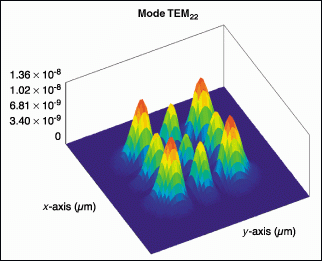



Press Coverage and Publications of LAS-CAD GmbH
Opto & Laser Europe, February, 1997:Hot-crystal simulation aids laser designWindows software that calculates how thermal effects in laser crystals distort beam shape is helping researchers to design microchip and high-power solid-state lasers (SSL).
Lascad was developed by a company in Munich, Micro Systems Design (MSD), for a German research project called µ-LAS led by Daimler-Benz. The objective was to design, simulate and construct miniature, integrated diode-pumped lasers. In these lasers thermal and optical effects interact strongly and must be considered simultaneously, said Konrad Altmann, director of MSD.
Diode-pumped solid-state lasers (DPSSL) suffer at high pump powers. When laser crystals get hot, the output power and beam tals get hot, the output power and beam temperature gradients in the crystal which cause a range of optical distortions. Accurate simulations need to take material parameters, resonator geometry and heat removal into account. Understanding these systems, which may contain nonlinear crystals for second harmonic generation, is far from straightforward, commented Altmann. Lascad models the behaviour on a PC with a graphical user interface.
The thermal lensing effect, where the crystal behaves as a lens and focuses the laser mode, is a well known problem in DPSSL. Temperatures are higher at the centre of the crystal, where the pump beam is intense and there is more heating than at the surface, which is often cooled.
Because refractive index varies with temperature, the crystal develops a radial refractive profile and starts to behave as a lens. The effect can be strong, with focal lengths of a few centimetres in high-power solid-state lasers (SSL, DPSSL). Since the strength of the lens changes with the operating conditions it is difficult to optimize a laser cavity design.
A related phenomenon is gain guiding, where the higher gain along the axis of the laser rod alters the beam shape and confines the laser-mode.
The heated crystal also deforms. Uneven expansion induces stress birefringence and may cause the crystal to crack or shatter in extreme cases.
Lascad runs under Windows on a PC. The laser cavity is built up on screen with the mouse inserting and positioning optical elements such as lenses and mirrors. Once in place, the user enters the power, wavelength and intensity distribution of the pump beam as well as material parameters such as thermal conductivity, thermal expansion and the doping level of the crystal.
The software then computes the three-dimensional distribution of temperature, deformation and stress in the laser crystal by a finite element method. The results are displayed on screen as 3-D colour images.
The package also shows the wavefront shape and intensity distribution of the laser mode as it propagates through the resonator. Calculations are based on the ABCD matrix approach and include a parabolic approximation for thermal lensing and gain-guiding. An overlap calculation of the gain distribution with the mode determines the power conversion and efficiency of the laser.
MSD is building up a database of popular laser materials. At the moment entries include neodymium, erbium, ytterbium and holmium-doped hosts. The company hopes to expand the database by co-operating with research institutes. The software compares the performance of different crystals by simply selecting the relevant database entry.
Work is underway to incorporate beam propagation method (BPM) algorithms. These will determine the shape of non-Gaussian laser modes more accurately and simulate the vector properties if the light wave.
MSD is currently involved in another German research project, LADI, to develop compact red, green and blue lasers for a display system. It will be built by Laser Display Technologie in Gera.
The Lascad package is available directly from MSD and costs DEM 8000.
Laser Focus World, May, 2000:Simulation software tackles design of laser resonatorsby Konrad Altmann
 Laser engineers are generally not inclined to use simulation
software for optimizing resonator design for a number of reasons
previously described in this publication (see Laser Focus
World, Jan. 1998, p. 207). One of the main reasons historically
has been that no software tool was available to rigorously analyze
the complicated, multiphysics interaction of thermal and optical
effects in solid-state lasers (SSL, DPSSL). Without this capability even highly
sophisticated optics codes fail to predict the correct behavior of
these lasers. Laser engineers are generally not inclined to use simulation
software for optimizing resonator design for a number of reasons
previously described in this publication (see Laser Focus
World, Jan. 1998, p. 207). One of the main reasons historically
has been that no software tool was available to rigorously analyze
the complicated, multiphysics interaction of thermal and optical
effects in solid-state lasers (SSL, DPSSL). Without this capability even highly
sophisticated optics codes fail to predict the correct behavior of
these lasers.To fill this gap, more-recently developed software combines several simulation tools to provide rapid analysis of the complex interactions in a resonator design. For instance, the LASCAD software package developed by Micro Systems Design GmbH (MSD; Munich, Germany) includes finite element code for thermal and structural analysis, a Gaussian ABCD matrix algorithm, and wave-optics code based on the beam-propagation method with the additional capability of numerical eigenmodes analysis (see Fig. 1). Laser engineering toolThe three-dimensional, nonlinear interaction of thermal and
optical fields, commonly known as thermal lensing, is one of the key
problems that designers of solid-state lasers (SSL, DPSSL) are confronted with
(see Laser Focus World, Dec. 1998, p. 129). This effect is of
growing importance due to the tendency to miniaturize laser systems
and simultaneously to increase their output power, causing the
interaction of strong fields in very small volumes. Thermal lensing
strongly depends on material parameters, resonator geometry,
pump-beam distribution, and cooling layout. It interferes with gain
guiding and other effects that control beam quality and efficiency
in a complicated manner. Numerical simulation plays an important
role in allowing laser engineers to preview and compensate for these
effects prior to committing hardware to a design concept.
Finite element analysis (FEA) is used to compute temperature
distribution, deformation, and stress or fracture mechanics in laser
crystals and to analyze the effect of different cooling layouts.
Though frequently applied in other engineering disciplines, FEA is
not very well known in laser technology. So predesigned finite
element models with adjustable parameters, such as dimensions and
FEA mesh, are provided to assist laser engineers with common
configurations, such as frontally pumped rods and blocks. Either
super-Gaussian functions or numerical input can also be used to
model pump-light distribution. A postprocessor with sophisticated
graphics visualization capability can enable display and editing of
FEA results (see Fig. 2). A finite-element preprocessor can also
generate models for special configurations, such as composite laser
materials with undoped regions. Models to fit many design needs may
also be found in growing vendor library resources or can often be
custom developed by the software vendor.
When FEA results are used with the ABCD matrix code in the LASCAD
system, the temperature distribution multiplied by the temperature
dependence of the refractive index is fitted parabolically at right
angles to the optical axis using the finite element mesh
subdivisions. In the same way, a fit of the deformed end faces of
the crystal is carried through. For many configurations, frontally
pumped rods, for example, this approximation delivers reliable
results for the laser mode. Results of the ABCD matrix code, the
fundamental mode spot size, and the phase front curvature along the
resonator axis can be displayed, as well as higher-order
Hermite-Gaussian polynomials. The ABCD matrix code completely takes
into account astigmatism, and computations are carried through in
two planes perpendicular to the resonator axis simultaneously.
 Parabolic approximation and ABCD matrix code are not always
sufficient, however. And in these cases FEA results can be
alternatively used as input for a wave optics code. The wave optics
code provides full 3-D simulation of the interaction of a
propagating wavefront with the hot, thermally deformed crystal,
without using parabolic approximation. For this purpose the code
propagates the wavefront in small steps through the crystal, taking
into account the transversal distribution of the refractive index,
as well as the deformed front facets of the crystal, as obtained
from FEA. A series of round-trips through the laser cavity is computed,
which finally converges to the fundamental or to a superposition of
higher order transversal modes. In addition, the wave optics code
takes into account diffraction effects due to light stops and the
finite transversal extension of mirrors. Mirrors with arbitrary
reflectivity variations in radial direction can also be considered. Parabolic approximation and ABCD matrix code are not always
sufficient, however. And in these cases FEA results can be
alternatively used as input for a wave optics code. The wave optics
code provides full 3-D simulation of the interaction of a
propagating wavefront with the hot, thermally deformed crystal,
without using parabolic approximation. For this purpose the code
propagates the wavefront in small steps through the crystal, taking
into account the transversal distribution of the refractive index,
as well as the deformed front facets of the crystal, as obtained
from FEA. A series of round-trips through the laser cavity is computed,
which finally converges to the fundamental or to a superposition of
higher order transversal modes. In addition, the wave optics code
takes into account diffraction effects due to light stops and the
finite transversal extension of mirrors. Mirrors with arbitrary
reflectivity variations in radial direction can also be considered.
Another important capability of wave optics code is the
simulation of misalignment influences that cannot be carried through
in a satisfactory manner with the ABCD matrix code. For evaluation
purposes, the wave optics code presents intensity and phase
distribution at the outcoupling mirror, and thus provides important
information about beam quality. This information may then be
compared directly with physical wavefront measurements after the
resonator is constructed. In addition, the wave optics code is
capable of numerically computing the spectrum of the laser cavity
eigenvalues and also the shape of the transverse eigenmodes (see
Fig. 3)
In addition to the computation of resonator modes, the ABCD
matrix code can also propagate the beam outside the resonator
through an external optical system. This capability is currently
implemented in LASCAD for the wave optics code. Gain distribution in
LASCAD is currently taken into account on the basis of an overall
power balance using the total loss of the resonator.
Development and evaluationTo verify the results of LASCAD simulation, MSD is cooperating
with German laser companies and universities in a research project
supported by the Bavarian Research Foundation (BRF; Bayerische
Forschungsstiftung, Munich, Germany). One of these companies, LASOS
GmbH (Jena, Germany), is simulating a microlaser with frontally
pumped rod and has achieved good agreement with measurements.
Richard Wallenstein's laser group at the University of
Kaiserslautern (Germany) performs analysis and optimization of
composite crystals in diode-pumped high-power picosecond lasers and
amplifiers. A detailed series of measurements was carried out, which
have determined the laser parameters carefully and verified the
simulation results. The laser division of Daimler-Chrysler AG
(Munich, Germany) which has cooperated with MSD in other research
projects for four years, has achieved good results from
incorporating simulation software into its laser systems. LDT
Laser-Display-Technology GmbH (Gera, Germany) simulates long, folded
resonators for second-harmonic generation.
 FIGURE 3. Hermite-Gaussian mode TEM22 was obtained
by numerical eigenmodes analysis. FIGURE 3. Hermite-Gaussian mode TEM22 was obtained
by numerical eigenmodes analysis.To facilitate comparison of simulated models with measurements of physical
systems, MSD and WaveFront Sciences (Albuquerque, NM) are
collaborating to allow easy translation of data between LASCAD and
WaveFront Sciences' Complete Light Analysis System (CLAS-2D).
|